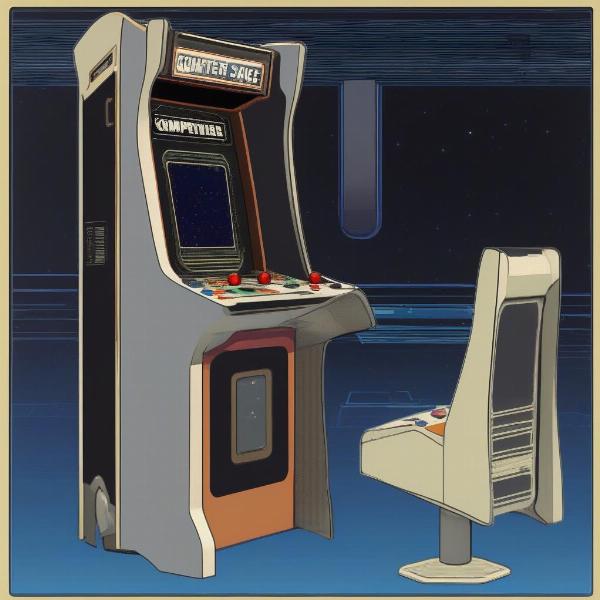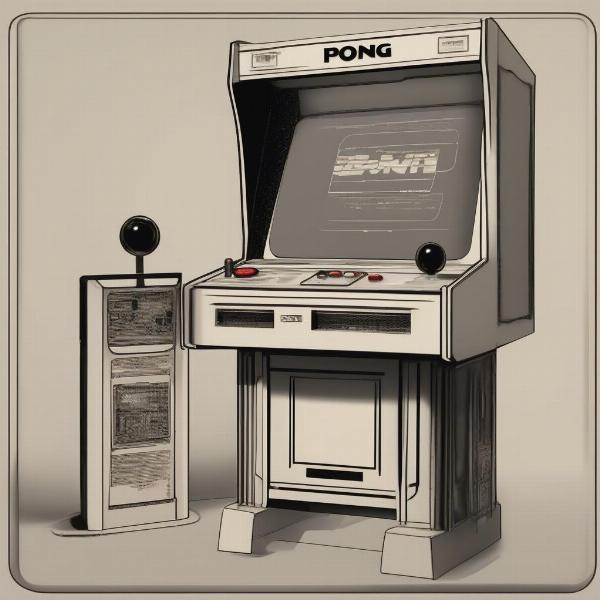The dawn of the arcade game era is a fascinating topic, and if you’re curious about when the first arcade game was made, you’re in the right place. The history of arcade games is richer and more complex than many realize, spanning several decades of innovation and evolution. Understanding this history provides a deeper appreciation for the games we enjoy today.
Pinball’s Influence and the Birth of “Computer Space”
While not strictly a video game, pinball played a significant role in paving the way for arcade gaming. The electromechanical nature of pinball machines, with their flashing lights and interactive gameplay, set the stage for the arcade experience. Then, in 1971, Nolan Bushnell and Ted Dabney created “Computer Space,” considered the first commercially available arcade video game. This space combat simulator, inspired by the popular “Spacewar!” game, marked a turning point in entertainment history. While “Computer Space” laid the groundwork, it wasn’t quite the breakthrough that would define the arcade scene.
 Computer Space Arcade Game Cabinet
Computer Space Arcade Game Cabinet
“Galaxy Game” and the Rise of Atari
Shortly after “Computer Space,” another game emerged that further pushed the boundaries of arcade gaming. In 1971, Bill Pitts and Hugh Tuck created “Galaxy Game,” a coin-operated version of “Spacewar!”. This game utilized a Data General Nova minicomputer, a powerful piece of technology for its time, demonstrating the potential for more complex and engaging arcade experiences. However, the high cost of this technology limited “Galaxy Game’s” widespread distribution. This led Bushnell and Dabney, the minds behind “Computer Space,” to found Atari in 1972, a company that would soon revolutionize the arcade world.
The Breakout Phenomenon and the Golden Age
Atari’s breakout hit, “Pong” (1972), solidified the arcade game’s place in popular culture. Its simple yet addictive gameplay captivated audiences and sparked a wave of innovation. This simple game of simulated table tennis became a cultural phenomenon, establishing video games as a mainstream form of entertainment. This period marked the beginning of the golden age of arcade games, with numerous companies entering the market and pushing the boundaries of technology and gameplay. The introduction of microprocessors in the mid-1970s allowed for more complex game logic and more detailed graphics.
 Atari Pong Arcade Cabinet
Atari Pong Arcade Cabinet
The Evolution Continues: From “Pac-Man” to Modern Arcades
The late 1970s and 1980s witnessed a surge in iconic arcade games like “Space Invaders,” “Pac-Man,” “Donkey Kong,” and countless others. These games further refined the arcade experience, introducing innovative gameplay mechanics, colorful graphics, and immersive sound effects. The arcade became a social hub, a place where friends gathered to compete and enjoy the latest gaming sensations. While the popularity of home consoles eventually impacted the arcade scene, arcades continue to evolve. Modern arcades now offer a mix of classic and contemporary games, virtual reality experiences, and other entertainment options, ensuring their continued relevance in the ever-changing landscape of gaming. To delve deeper into contemporary game development, consider reading more about when the Bedlam game is expected when is the bedlam game.
The Impact of Arcades on Gaming Culture
Arcade games have left an indelible mark on gaming culture. They not only provided countless hours of entertainment but also inspired generations of game developers and shaped the future of the gaming industry. The competitive nature of arcade games, with their high score tables and focus on skill, fostered a sense of community and drove innovation. The impact of arcade gaming can be seen in the design, mechanics, and aesthetics of many modern games.
 Classic Arcade Games – Pac-Man and Space Invaders
Classic Arcade Games – Pac-Man and Space Invaders
What is considered the first arcade game?
“Computer Space,” released in 1971, is generally considered the first commercially available arcade video game.
Who invented the first arcade game?
Nolan Bushnell and Ted Dabney are credited with creating “Computer Space,” the first arcade game.
When did arcades become popular?
Arcades gained widespread popularity in the late 1970s and early 1980s with the release of iconic games like “Pac-Man” and “Donkey Kong.”
What was the first successful arcade game?
While “Computer Space” was the first, “Pong” (1972) is often considered the first commercially successful arcade video game.
What was the golden age of arcade games?
The golden age of arcade games is generally considered to be the late 1970s and 1980s, a period of rapid innovation and widespread popularity.
Why did arcades decline in popularity?
The rise of home consoles, offering a more affordable and convenient gaming experience, contributed to the decline of arcade popularity.
Do arcades still exist today?
Yes, arcades still exist, albeit in a different form. Modern arcades offer a mix of classic games, newer titles, and other entertainment options.
In conclusion, while pinpointing the exact moment the first arcade game was made requires understanding the nuances of gaming history, “Computer Space” in 1971 stands as a pivotal moment. From those early beginnings, arcade games have evolved dramatically, shaping the gaming landscape and leaving an enduring legacy. The next time you play a game, take a moment to appreciate the rich history of arcade gaming that paved the way for the immersive experiences we enjoy today.

